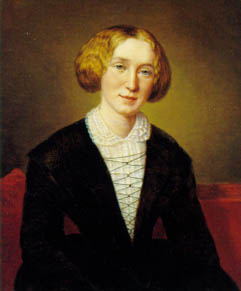This month, we celebrate the life of the acclaimed Victorian novelist, journalist, and translator. The author of seven novels, she is renowned for capturing life in rural England and bringing psychological analysis to modern literature.
 George Eliot, born Mary Ann (Marian) Evans, was born on November 22, 1819 in Warwickshire, England. Eliot showed signs of great intelligence at a young age. Her father felt encouraged to spend money on a private education for her, unusual for women at this time. From age five to sixteen, Eliot attended three different boarding schools, enriching her mind on knowledge of classic Greek literature and various languages. When Eliot was sixteen, her mother died and Eliot did the respectable thing of going home to resume the position of caretaker. Despite leaving her structured schooling behind, she never stopped her education and continued to teach herself and had lessons in Latin and German. When her brother came of age, he took over the family home and Eliot and her father moved to Coventry.
George Eliot, born Mary Ann (Marian) Evans, was born on November 22, 1819 in Warwickshire, England. Eliot showed signs of great intelligence at a young age. Her father felt encouraged to spend money on a private education for her, unusual for women at this time. From age five to sixteen, Eliot attended three different boarding schools, enriching her mind on knowledge of classic Greek literature and various languages. When Eliot was sixteen, her mother died and Eliot did the respectable thing of going home to resume the position of caretaker. Despite leaving her structured schooling behind, she never stopped her education and continued to teach herself and had lessons in Latin and German. When her brother came of age, he took over the family home and Eliot and her father moved to Coventry.
Eliot was raised in a Low Church Anglican family, relying heavily on Biblical teachings and less on a structural church ceremony. However, her move to Coventry introduced her to a circle of literary friends who challenged her religious views, causing her to part with the ideals of her church. Eliot confided to her father that she'd renounced the church. He threatened to throw her out of his home, but a compromise was soon proposed, and as long as she appeared at church respectably, she was allowed to think what she wanted and live in his home. She abided by his rules until he died in 1849.
Following her father’s death, Eliot travelled throughout Europe, and upon her return to London, she decided to become serious about writing and did so under the name Marian Evans. It was only later that she would adopt the pen name with which we are all familiar. Eliot lived with radical publisher John Chapman, who hired Eliot to work as the editor of The Westminster Review. But Eliot essentially did the work of the editor, without the remuneration or credit, which eventually resulted in a dissolution of the relationship (which wasn't aided by Eliot's unrequited romantic attachment to the married Chapman). There were plenty of female authors at the time--the Bronte sisters, Elizabeth Gaskell, and Christina Rosetti, for instance--but it was incredibly unusual for a woman to hold the kind of leadership position that Eliot had at the Review.
One of the most popular and longest scandals was her relationship with George Henry Lewes, her best friend, lover, and muse. Lewes was married to Agnes Lewes, who bore two children by another man during the marriage. After the second child, the couple separated and Eliot was welcomed into his home. The true story was not greatly publicized at the time due to the great taboo of illegitimate children and divorce. The relationship between Lewes and Eliot caused the loss of many friends and family, but they were a healthy and happy couple.
Lewes encouraged her to write and in 1856 “Scenes of a Clerical Life” was published in a magazine, illustrating the lives and setting of rural life in Warwickshire. The story was positively reviewed and in 1859, Eliot's first novel, Adam Bede was published. Although she had no doubt in her novel being published, she wrote it under the pseudonym ‘George Eliot’ to ensure that her writing would be read seriously and that her sex would not motivate a particular audience or critical response. It was another great success, and has remained in print since its publication.
Next came Silas Marner (1861) and Middlemarch (1871-1872). Both were critically acclaimed, and the latter is considered her masterpiece. Martin Amis called it the greatest novel in the English language, and Virginia Woolf said that Middlemarch was "one of the few English novels written for grown-up people." All of Eliot's books are still widely taught as part of nineteenth-century British literature courses. Her last novel, Daniel Deronda, was published in 1876.
Two years later, her beloved Lewes died. Following his death, Eliot found comfort in her longtime friend, John Walter Cross, a banker twenty years younger than she, who was also grieving over the death of a loved one. In May of 1880, they were married and Eliot changed her name her Mary Ann Cross. After their wedding trip in Italy, they settled into her country home in England, where she died in December of that year at the age of 61.








